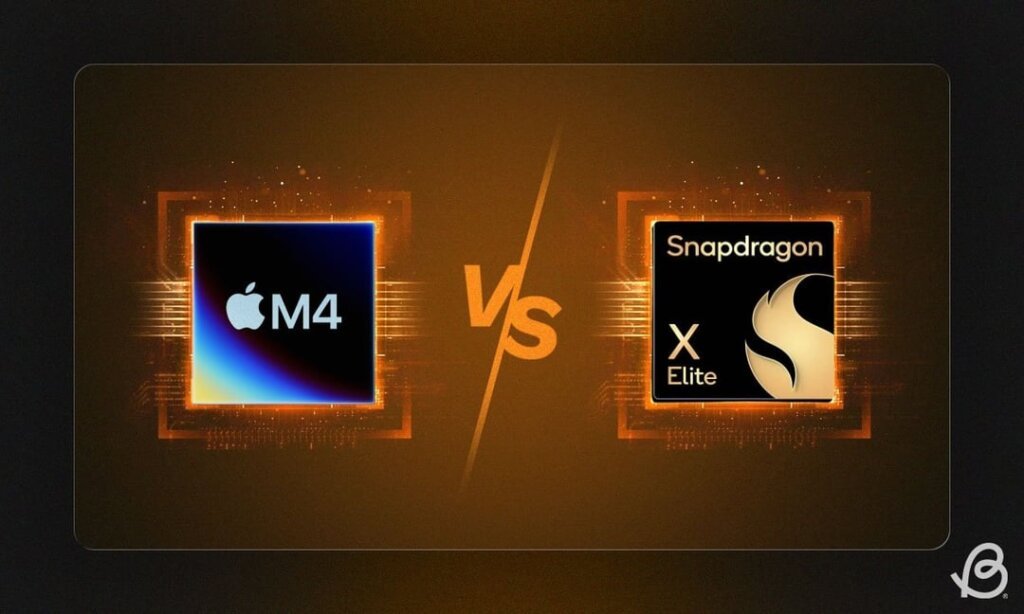Why the Gap Exists in the First Place
In recent years, the shift to its own silicon, beginning with the M1, then the M2, M3, and M4/M5, has given Apple a steady performance-per-watt, integration, and sustained system efficiency lead. The close integration of hardware, operating system, memory architecture (unified memory), and workload scheduling provides Apple with some non-core benefits. M-series chips are tested in academic studies, including high memory throughput, effective (highly efficient) GPU-CPU cooperation, and good results in general compute and high-performance tasks.

Meanwhile, Qualcomm has its strong points in mobile SoCs, cellular modems, graphics processing unit/internet protocol in Adreno, and recently increased ambition in laptop/PC class chips. However, historically, Snapdragon or mobile chips have been designed to operate within limited power envelopes, which made it more challenging to achieve the sort of bursts in performance and lengthy sustained workloads that the desktop variant, made by Apple, can achieve.
Therefore, the distance is not attributed to one thing- it is a compound of architecture, integration, system software, and power envelopes.
Signs That Qualcomm Is Closing In
According to recent developments, Qualcomm is furiously closing the gap in a variety of fronts:
1. New flagship chips with better design and process
During the Snapdragon Summit, Qualcomm unveiled a new CPU/GPU/NPU called Snapdragon 8 Elite Gen 5 that is more efficient. Certain reports suggest that this chip is doing well in benchmark terms, as well as in some cases, outperforming Apple’s recent silicon.
Qualcomm is also said to be moving to newer ARM-based designs and using some of the newer process nodes (e.g., N3P) to cut down on power and increase the speed.
2. Focus on AI and NPU improvements
Another area in which Qualcomm can improve faster is neural processing / AI. Qualcomm HEE (Hexagon AI engine) has been upgraded in a continuous manner, especially regarding on-device inference. In the meantime, Apple Neural Engine is very optimized to execute the machine learning frameworks of Apple machines, yet it has its scaling problems as well.
More recent chips produced by Qualcomm (such as Snapdragon X2 Elite) have high AI benchmark results, which, in some measures, outperform the M4 NPU of Apple.
That provides Qualcomm with an advantage in fields such as vision, translation, and on-device AI work, differentiators not just based on raw CPU speed.
3. Stronger architecture choices (custom cores, branch prediction, etc.)
The acquisition of Nuvia (established by former Apple CPU architects) by Qualcomm has produced custom CPU core designs (Oryon cores). These cores target increased IPC (instructions per clock) and improved branch prediction, reducing microarchitectural distances to the Firestorm / Icestorm tradition of Apple.
Researchers have also analyzed conditional branch predictors in Apple vs Qualcomm cores, showing what optimizations can be done by Qualcomm.
The Challenges Qualcomm Still Faces
Despite powerful moves, Qualcomm still has a number of structural issues that prevent it from having instant parity.
Power and thermal envelopes
The designs of Apple M-series have the advantage of being in a controlled thermal environment (MacBooks, iPads) where power consumption can be increased during bursts. Qualcomm targets form factors such as mobile and Windows laptops that are constrained. Overloading may cause heat, battery life, and throttling, which has already become apparent in some of the thin Windows machines based on Snapdragon chips.
Software and OS integration
Apple has huge advantages because it has a monopoly over the macOS + operating system with hardware and memory. Qualcomm needs to collaborate with 3-party drivers, external OS vendors (Microsoft, OEMs). That introduces fragmentation and overhead and makes it more difficult to get full hardware capacity.
Memory architecture and bandwidth
Apple’s cohesive memory provides access with low latency and high bandwidth through CPU/Neural Engine/GPU. Crossing of domains and interconnect overheads have to be dealt with at Qualcomm, and this could become a bottleneck, particularly in large workloads or AI inference.
Ecosystem and developer tools
The frameworks (Core ML, Metal) of Apple are tightly optimized by developers. Qualcomm must serve a wide range of ML platforms and toolchains in Android, Windows, and hybrid systems. It is always a question of years to make sure that the software completely uses the hardware.
Will Qualcomm Close the Gap? My Outlook
Yes–but not all, not at once, and not everywhere. I think in 2-3 years, Qualcomm will bridge the performance gap in most real-world work (particularly AI, GPU, burst workloads). Qualcomm already seems to be competitive in some benchmarks.
Nevertheless, Apple will probably continue to have an advantage in its vertical control in terms of long-term workload, system efficiency, and smooth integration of the OS. The margin will change: Apple will not win so much in terms of numbers, but in terms of sophistication and reliability.
By 2027- 2028, Qualcomm-based PCs/laptops/tablets may be completely competitive across many creative, AI, and productivity workloads. The dominance of Apple in terms of developer ecosystem, hardware-software synergy, and stability of performance will be a hard standard to follow.




